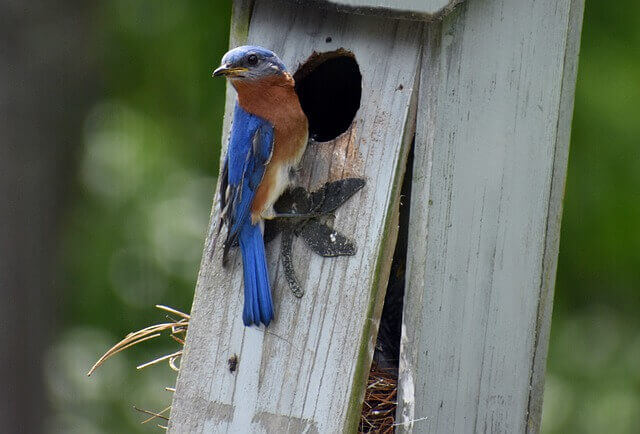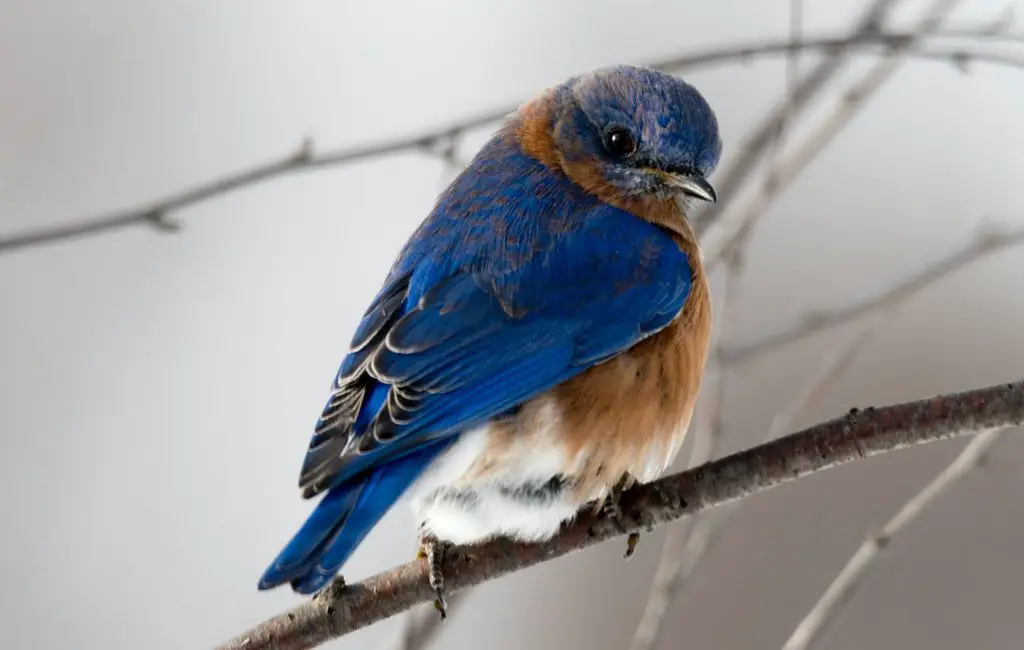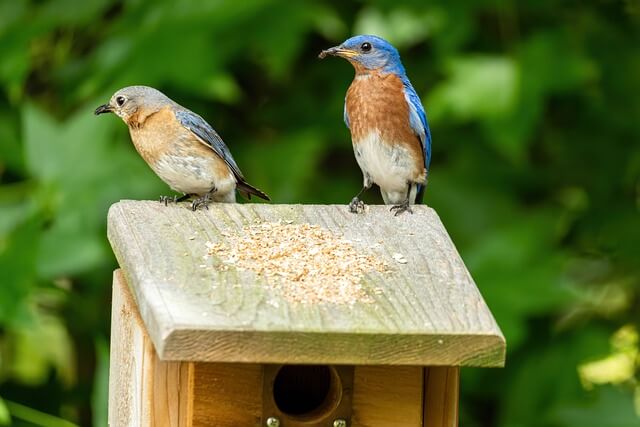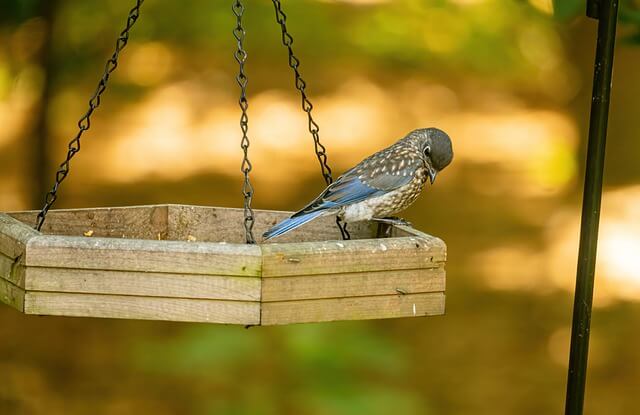
Dive into the captivating world of Eastern Bluebirds! Explore 70 Fun Facts About Eastern Bluebirds as we uncover their mesmerizing behaviors, stunning plumage, and intricate social dynamics. From their melodious songs to their unique nesting habits, join us on a journey that celebrates the charm and wonder of these delightful creatures!
Table of Contents
- 1 Overview of the Eastern Bluebird
- 2 Fun Facts About Eastern Bluebirds
- 3 Attracting Bluebirds
- 4 Frequently Asked Questions
- 4.1 Is the Eastern Bluebird rare?
- 4.2 Do Bluebirds come back to the same nest every year?
- 4.3 Are Bluebirds friendly?
- 4.4 Why do Bluebirds puff up?
- 4.5 Do Bluebird pairs stay together?
- 4.6 What it means to see a bluebird?
- 4.7 Why are Eastern Bluebirds important?
- 4.8 Do bluebirds sing?
- 4.9 How rare is a blue bird?
- 4.10 Are blue birds good luck?
- 4.11 Where do bluebirds go in the winter?
- 5 Author
Overview of the Eastern Bluebird
- Identification: The eastern bluebird (Sialia sialis) is a small bird native to North America. The average size is 6.75 inches (17 cm) in length. It has a gray-blue back, rusty-orange breast, and white belly with brown spots. They look like small robins with a distinct blue color on their wings, tail and head.
- Length: 16–21 cm (6.3–8.3 in).
- Weight: 27–34 g (0.95–1.20 oz).
- Wingspan: 25–32 cm (9.8–12.6 in).
- Kingdom: Animalia
- Phylum: Chordata
- Class: Aves
- Order: Passeriformes
- Family: Turdidae
- Genus: Sialia
- Species: S.sialis
- Binomial Name: Sialia sialis (Linnaeus, 1758)
- Scientific Name: Sialia sialis
- Range: Eastern bluebirds are found across North America. In the eastern United States, their range stretches from the Atlantic coast to about the Rocky Mountains and on into Texas. In Canada, they live as far north as Nova Scotia and Newfoundland in the east. Eastern bluebirds also can be found throughout Mexico and Central America.
- Migration: These birds migrate south for the winter and return north when spring arrives. Eastern bluebirds are small, native North American songbirds that typically spend their winters in Central America or South America before returning to their breeding grounds as the weather warms up in late March or early April.
- Habitat: They inhabit forests, meadows, parks, golf courses, grasslands, marshes, woodlands and farmland in rural areas throughout this region.
- Diet: The diet consists mostly of insects such as grasshoppers ants, spider and beetles, which they glean from tree branches or ground vegetation; however, bluebird will also eat small fruits and berries during fall migration.
- Global extent of occurrence: 14,800,000 km2. (5714311.9464 sq mi.).
- Global Population: est. 23,000,000 Individuals.
- Conservation Status: Listed as Least Concern (Population is increasing).
- Lifespan: In the Wild: 6 years of age. – In Captivity: 10 years of age.
- Breeding Period: April through July.
- Incubation Duration: 11-19 days.
- Chicks Fledge: 16-25 days.
- Clutch Size: 3-7 eggs.
- Number of Broods: 1-3 brood per year.
- Egg Color: Bluish-white.
- Nesting Habits: They build nests in tree cavities or bird boxes, choosing sites with good visibility, low on tree trunks or on fence posts. They may also take over abandoned nests of other birds if they feel threatened. Female Eastern Bluebirds lay between three and seven eggs, which can be greenish white to sky blue with dark spots on them. The female incubates the eggs for about two weeks before hatching. The male helps feed the hatchlings, as well as bringing food to his mate while she sits on the nest. Eastern bluebirds reach sexual maturity at one year.
Fun Facts About Eastern Bluebirds
- The Eastern Bluebird was first described in 1758 by Carl Linnaeus, a Swedish naturalist and zoologist.
- The female Eastern Bluebird is the dominant bird in their relationship. The male will often do everything that the female wants him to do – including any home improvements to the nest and even hunting for food.
- The longest recorded lifespan for a bluebird is almost 11 years.
- Unlike many other birds, bluebirds are not very vocal animals. They typically only use a few different sounds to communicate with each other. These sounds include a chirp, a trill, and an alarm call which is also used to warn other birds away from their nest.
- The Eastern Bluebird was on the verge of becoming extinct in the early 1900s due to massive loss in habitat and competition with other birds such as House Sparrows and European Starlings. Luckily, conservation efforts have increased their population, so they are no longer on the list of endangered species.
- These beautiful birds will gladly eat mealworms, so if you want to help them raise their young, you can provide mealworms at your local bird store or buy them online, and they will appreciate it!
- Bluebirds are a type of songbird that belong to the thrush family.
- They are native to North America and can be found in open woodlands, meadows, orchards, and gardens.
- The most common type of bluebird in North America is the Eastern Bluebird.
- The Eastern Bluebird, which is native to the eastern United States and Canada, is the official state bird of both Missouri and New York.
- It is one of the three species of bluebirds that can be found in North America.
- These birds are monogamous and will mate for life, but they do take new mates if their partner dies or disappears.
- They are not migratory, but will move south or to a lower elevation for the winter when food becomes scarce.
- Eastern Bluebirds feed on insects such as grasshoppers, crickets, beetles, caterpillars, moths, flies, wasps, ants, and spiders. They also eat fruit in the fall and winter months, when insects are scarce.
- They are ground foragers and will hunt for food in open fields or grasslands. Furthermore, they will often hop along the ground using their feet to flip over leaves or soil in search for prey insects like grasshoppers or crickets.
- A flock of bluebirds is called a ‘flock’.
- Bluebirds will frequently use cavities like old woodpecker holes for their nests, but they will also use birdhouses that have been put out for them by humans (although some prefer to build their own homes).
- The female will lay 3-7 eggs, which take two weeks to hatch, with both parents incubating the eggs and feeding their young once they’ve hatched.
- Both male and female bluebirds have blue feathers on their wings with red breasts, but you can tell them apart by the color of their throats: males have a red throat, while females have a grayish-blue throat with white spots on it.
- Though these birds prefer to stay in the eastern part of North America, they have been found in parts of Canada and western United States as well. They are migratory birds and usually head south for winter.
- Bluebirds live up to 6 years in the wild, but have been known to live as long as 10 years in captivity. If you want to attract bluebirds to your yard, put out an attractive birdhouse and keep your yard free of weeds and shrubs so that these beautiful birds can easily find insects and worms for food!
- Bluebirds nest from February through September, but tend to prefer nesting sites that are not too near human activity, so try not to disturb them if you see them building a nest!
- Bluebirds are cavity-nesters, meaning they prefer to nest in hollowed out cavities, choosing sites with good visibility, up to 50 feet high on tree trunks or on fence posts. They will also use nesting boxes, which can be great for bluebird conservation.
- Bluebirds only flutter their wings when they are on the ground and trying to attract a mate. When they take off from the ground or take flight, they soar up and away without fluttering at all.
- Bluebirds are omnivorous, meaning they eat insects and fruit. Their favorite insect is the grasshopper!
- Eastern bluebirds eat insects, fruits and berries during warmer months when insects are abundant. During the winter, they eat mostly berries. Sometimes they will even visit hummingbird feeders for a sip of nectar!
- Did you know that bluebirds can fly at speeds up to 17 miles per hour? That’s pretty fast! Bluebirds are able to fly so fast because they have long, pointy wings that help them slice through the air. When they’re flying, they look like they’re just a blur!
- During the winter months, bluebirds often form flocks with other types of thrushes.
- Bluebirds are considered a sign of good luck in many cultures.

Attracting Bluebirds
Are you looking for a way to attract bluebirds to your yard? You can use a variety of techniques to entice these beautiful birds. Check out our 11 tips below!
1) Keep it clean – Eastern bluebirds will be less likely to visit if they find too much trash or debris in their path.
2) Eastern bluebirds are attracted to well-maintained lawns with a variety of flowers and food sources nearby, such as shrubs or fruit trees.
3) These birds have a preference for eating bugs and fruit so make sure you leave some food out for them such as mealworms or oranges!
4) Avoid excessive noise.
5) Bluebird nest boxes can be bought on Amazon, or they can be made by hand from recycled materials. 2) Fill the box with natural nesting material like shredded paper, straw, leaves, sticks and grasses. 3) Place the box in an open area near a tree for protection from predators.
6) Plant native plants that offer good sources of food and shelter. Eastern bluebirds like a variety of berries, such as elderberries, huckleberries, chokecherries, currants, service berry, and sumac.
7) Add fruit trees and bushes such as mulberry, elderberry, cotoneaster, crabapple, berries, cherries, grapes, apples, or pears.
8) Offer water sources-a birdbath, or even just a shallow dish with some stones in it, so the birds can reach in and drink from the edge.
9) Provide feeders filled with black oil sunflower seeds (don’t forget the mesh netting!) and peanuts.
10) Provide bird feeders with plenty of high-quality seed such as sunflower seeds, or cracked corn throughout the year to provide an adequate food supply for these cavity nesters. There are many feeders that are designed to attract these birds in your yard. Find the lowest price on a bluebird feeder on Amazon.
11) Leave standing dead trees with thick bark as roosting spots during winter months.
Frequently Asked Questions
Is the Eastern Bluebird rare?
Eastern bluebirds are a bird species that is fairly rare. There are many reasons for this, such as habitat loss and lack of breeding sites. However, there have been recent sightings in other areas which may be an indication that the Eastern Bluebird population is growing.
Do Bluebirds come back to the same nest every year?
Bluebirds are well known for their return each year to the same location where they mate and nest. But, is this true? For a pair of bluebirds to return to the same nest in successive years, there must be adequate shelter and food sources near their nesting site from one season to another; plus an adequate number of desirable nesting sites to choose from.
Are Bluebirds friendly?
Bluebirds can be very friendly to people, as they will often eat from your hand or come close enough for you to touch them.
Why do Bluebirds puff up?
Bluebirds puff up because they are trying to show their dominance. They will often puff up when they are scared or threatened by another bird. This is not a sign of aggression, but rather an attempt to scare off the other bird.
Do Bluebird pairs stay together?
Bluebirds typically mate for life; however, some pairs may separate due to injury or death of one of the mates.
What it means to see a bluebird?
Seeing a bluebird can have different meanings to people. Some may see it as an omen, while others may not. To some people, seeing a bluebird means that they will find love in the near future. Others may think of the bird as an indicator of good luck or happiness. It is often seen as a sign from heaven for those who are going through tough times and need something to give them hope.
Why are Eastern Bluebirds important?
First, Eastern bluebirds help control insect populations. These birds primarily eat insects, which helps to keep these pests in check. This is especially beneficial for farmers and gardeners who rely on bluebirds to help protect their crops. Second, Eastern bluebirds play a role in seed dispersal. As they eat fruits and berries, they spread the seeds of these plants throughout their range. This assists the development of new plants, allowing them to flourish in different locations. Finally, Eastern bluebirds are indicators of environmental health.
Do bluebirds sing?
These beautiful birds are known for their throaty, short notes and whistles. While the males typically do most of the singing, females will also sing occasionally. Although their song is not as melodious as some other birds, it is still quite pleasant to listen to. Bluebirds typically sing in the spring and summer months, when they are mating and nesting. Their song is used to attract mates and ward off rivals.
How rare is a blue bird?
While the populations of some bluebird species have declined in recent years, others are doing quite well. The overall abundance of bluebirds varies depending on the region, but they are generally not considered to be rare birds.
Are blue birds good luck?
Yes, blue birds are considered to be good luck in many cultures. In China, the bluebird is a symbol of happiness and love. In Native American folklore, the bluebird is a sign of hope and renewal. And in Europe, the bluebird is associated with springtime and new beginnings. So if you see a bluebird, it just might be a sign that good things are on the way!
Where do bluebirds go in the winter?
Depending on the region, bluebirds may be year-round residents, or they may migrate south for the winter. The majority of bluebirds that migrate do so in late fall, with some birds traveling as far south as Central America. While on their wintering grounds, these birds form small flocks and can often be seen perching in trees or bushes. In some cases, however, bluebirds may remain in their northern homes throughout the winter if conditions are favorable.
Related Posts:




